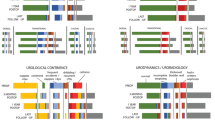Abstract
Objects
The authors report results of preoperative and postoperative urodynamic studies (UDS) and prognostic factors of urologic outcome in cases of lumbosacral lipomas for which prolonged follow-up data were available.
Materials and methods
The present series includes 42 consecutive cases of lumbosacral lipoma in patients aged 2 months to 15 years who underwent untethering operation during the period from 1986 to 1997. All of them underwent preoperative and postoperative UDS. At the last follow-up (mean duration of follow-up 108 months, range 44 to 176 months), 26 cases maintained social continence with or without intermittent catheterization. Young age (≤12 months) at operation, preoperative absence of urologic symptoms, and absence of neurologic abnormalities were significantly correlated with favorable urologic outcome.
Conclusion
UDS in cases with lumbosacral lipomas is a valuable tool for detecting neurourologic abnormalities as well as for monitoring the postoperative course and guiding management. History taking and neurologic examination are also proved to be important aspects in the evaluation of children with lumbosacral lipomas, predictive of urologic outcome. Better urologic results are anticipated if surgery is performed when the child is 12 months old or younger.
Similar content being viewed by others
References
Anderson FM (1975) Occult spinal dysraphism. Pediatrics 55:826–835
Atala A, Bauer SB, Dyro FM, Shefner J, Shillito J, Sathi S, Scott RM (1992) Bladder functional changes from lipomyelomeningocele repair. J Urol 148:592–594
Bauer SB, Hallett M, Khoshbin S, Lebowitz RL, Winston KR, Gibson S, Colodny AH, Retik AB (1984) Predictive value of urodynamic evaluation in newborns with myelodysplasia. JAMA 252:650–652
Chapman PH (1982) Congenital intraspinal lipomas. Anatomic considerations and surgical treatment. Childs Brain 9:37–47
Foster LS, Kogan BA, Cogen PH, Edwards MSB (1990) Bladder function in patients with lipomyelomeningocele. J Urol 143:984–986
Harrison MJ, Mitnick RJ, Rosenblum BR, Rothman AS (1990) Leptomyelolipoma: analysis of 20 cases. J Neurosurg 73:360–367
Hellstrom WJG, Edwards MSB, Kogan BA (1986) Urological aspects of the tethered cord syndrome. J Urol 135:317–320
Hoffman HJ, Taecholarn C, Hendrick EB, Humphreys RP (1985) Management of lipomyelomeningoceles. J Neurosurg 62:1–8
Kanev PM, Bierbrauer KS (1995) Reflections on the natural history of lipomyelomeningocele. Pediatr Neurosurg 22:137–140
Kanev PM, Lemire RJ, Loeser JD, Berger MS (1990) Management and long-term follow-up review of children with lipomyelomeningocele. J Neurosurg 73:48–52
Kaplan WE, McLone DG, Richards I (1988) The urological manifestations of the tethered spinal cord. J Urol 140:1285–1288
Keating MA, Rink RC, Bauer SB, Krarup C, Dyro FM, Winston KR, Shillito J, Fischer EG, Retik AB (1988) Neurourological implications of the changing approach in management of occult spinal lesions. J Urol 140:1299–1301
Kim KM, Choi H (1993) Urodynamic evaluation in pediatric neurogenic bladder. J Korean Med Sci 8:197–201
Kim KM, Jung JY, Kim DK (1998) Urodynamic evaluation of neurosurgical effect in myelodysplasia. Korean J Urol 39:266–270
Linder M, Rosenstein J, Sklar FH (1982) Functional improvement after spinal surgery for the dysraphic malformations. Neurosurgery 11:622–624
Lunardi P, Missori P, Ferrante L, Fortuna A (1990) Long-term results of surgical treatment of spinal lipomas. Report of 18 cases. Acta Neurochir (Wien) 104:64–68
McGuire EJ, Woodside JR, Borden TA, Weiss RM (1981) Prognostic value of urodynamic testing in myelodysplastic patients. J Urol 126:205–209
McLone DG, Naidich TP (1986) Laser resection of fifty spinal lipomas. Neurosurgery 18:611–615
Pang D (1996) Tethered cord syndrome. In: Wilkins RH, Rengachary SS (eds) Neurosurgery, 2nd edn, vol 3. McGraw-Hill, New York, pp 3465–3496
Pierre-Kahn A, Zerah M, Renier D, Cinalli G, Sainte-Rose C, Lellouch-Tubiana A, Brunelle F, Le Merrer M, Giudicelli Y, Pichon J, Kleinknecht B, Nataf F (1997) Congenital lumbosacral lipomas. Childs Nerv Syst 13:298–335
Satar N, Bauer SB, Scott RM, Shefner J, Kelly M, Darbey M (1997) Late effects of early surgery on lipoma and lipomeningocele in children less than 1 year old. J Urol 157:1434–1437
Sathi S, Madsen JR, Bauer S, Scott RM (1993) Effect of surgical repair on the neurourologic function in infants with lipomeningocele. Pediatr Neurosurg 19:256–259
Schut L, Derek MD, Sutton LN (1982) The management of the child with a lipomyelomeningocele. In: Weis MH (ed) Clinical neurosurgery, vol 23. Williams and Wilkins, Baltimore, pp 464–476
Wu H, Kogan BA, Baskin LS, Edwards MSB (1998) Long-term benefits of early neurosurgery for lipomyelomeningocele. J Urol 160:511–514
Yoneyama T, Fukui J, Ohtsuka K, Komatsu H, Ogawa A (1985) Urinary tract dysfunctions in tethered spinal cord syndrome: improvement after surgical untethering. J Urol 133:999–1001
Acknowledgment
This study was partly supported by the BK 21 Human Life Sciences Project, Republic of Korea.
Author information
Authors and Affiliations
Corresponding author
Rights and permissions
About this article
Cite this article
Kang, HS., Wang, KC., Kim, K.M. et al. Prognostic factors affecting urologic outcome after untethering surgery for lumbosacral lipoma. Childs Nerv Syst 22, 1111–1121 (2006). https://doi.org/10.1007/s00381-006-0088-5
Received:
Published:
Issue Date:
DOI: https://doi.org/10.1007/s00381-006-0088-5




